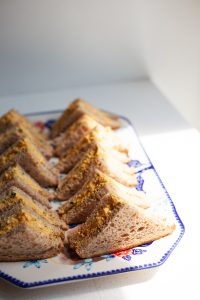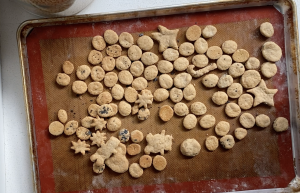Babies are real polluters. Did you know that one baby sends up to 7,000 disposable diapers to a landfill during their lifetime? And don’t forget all the clothing, accessories and baby products designed for short-term use.
Ironically, our desire to give our children the world is part of the problem. We really should focus on — in my opinion — giving them a healthier world. Early on in my pregnancy, I pledged to be as eco-friendly as possible while raising my child. Wanna know one of the easiest ways to do that? Buy as little new stuff as possible!
Other than gifts, our daughter owns few new things. Most of our baby gear is second-hand, from the stroller to the bassinet. There are exceptions, of course, mainly for feeding accessories.
We accept hand-me-downs with open arms — like wide open! That approach has landed us loads of stuff from generous friends and family. As for everything else, we shop on Kijiji or Facebook Marketplace. One of the best parts? We saved an estimated seven grand! Yep, I did the math.
My best finds include:
- Uppa Baby Vista, $275 (Original price: $1250 +tx)
- Ergobaby carrier, $30 (Original price: $120 +tx)
- A Maxi Cosi Mico AP, $75 (Orginal price: $400 +tx)
- Zippered PJs, $3 apiece (Orginal price $15-20)
- Bum Genius Cloth diapers, $12 apiece (Original price $25 +tx)
Most of the items I purchased were about four years old, so they didn’t look as sharp as the newest models, but who cares?
A lot of people asked me how I was able to find such goodies for so cheap. As an experienced second-hand online shopper, I decided to share a few tips to help parents get started.
Tip 1: Start early
Start browsing the web for second-hand baby items as soon as possible. If you can anticipate what you need ahead of time, you won’t be stuck running to the store last minute. The more time you have to shop, the more likely you’ll find what you need at a great price. The advantage of time also makes negotiating prices and coordinating pick-ups much easier. If you’re expecting a baby, search for big-ticket items immediately, even if you plan to buy a bit later. I started browsing early on but only purchased after the first trimester when I felt ready to start collecting baby gear. By browsing early, you’ll learn what’s out there. For example, in Montreal, City Mini strollers are ample, but Uppa Baby strollers are rare. Knowing this ahead of time will help you make quicker decisions.
Tip 2: Get the apps
You probably don’t need another reason to check your phone, but having the online marketplace apps on your phone will make it easier for you to keep up with new sellers. In Montreal, the two most popular ones are Kijiji and Facebook Marketplace. Both apps are intuitive and allow you to chat with the sellers, making it easy to communicate and coordinate. You can also consider Craigslist, eBay or other local apps. When pregnant, I’d peek on the apps on my commute or while waiting in line for coffee.
Tip 4: Don’t be afraid to negotiate
Many times while shopping on Kijiji, you might become discouraged because the seller is asking for more than you’re willing to spend. Why buy a bottle warmer for $30 when you can get it for $40 brand new? Figure out what is fair for you. For me, I generally expected to pay 50% of the original value of the item. So if the bottle warmer is $40 brand new, I’d expect to pay $20 for it. If the seller is asking for $30, I’d politely offer $20. More often than not, they agree. The reality is that for a lot of items, there are more sellers than buyers, so why not try and get the price you want?
Tip 5: Research products and go for popular quality brands
Just because you’re shopping for used stuff doesn’t mean you can’t visit your local baby store and browse. Figure out what model you’d purchase if you were going to buy it new. Ask retailers what the best-sellers are, so you know what models might be floating around online. When I started stroller shopping, I knew I wanted an Uppa Baby or a City GT Mini because they were trendy near me. I searched for those brand names every day to see the offers. And there were many! Knowing the brand you want helps you narrow your search so you don’t get overwhelmed.
Tip 6: Learn about safety
Some items are risker to buy second-hand. For example, cribs, bassinets, car seats, play yards and high chairs need to be recent enough to meet current safety standards. Always ask the seller when they bought it and how long it was used. With this knowledge, a little research and a visit to the manufacturer’s website, you can usually figure out whether an item is up to snuff. Canada has a guide for buying second hand. https://www.canada.ca/en/health-canada/services/consumer-product-safety/reports-publications/consumer-education/information-shoppers-second-hand-products.html
You should also visit https://healthycanadians.gc.ca/recall-alert-rappel-avis/index-eng.php to check if the baby item you’re interested in buying has been recalled. Just remember that antique bassinets may look beautiful, but they may not be worth the risk.
A note about car seats:
Whether you buy a car seat used or not is a personal choice. I wouldn’t advise anyone to do so unless they are comfortable with it. Lots of people discouraged me from buying used because of safety concerns. In Canada, there are three important considerations when purchasing a used car seat.
- It must not be expired.
- It must be Canadian certified.
- It must never have been in a collision.
You can easily find the expiration date and Canadian certification on the bottom of the seat and seat base (for infant car seats). Make sure the car seat you’re considering has at least 18 months left to allow you to use it for as long as possible. You’ll also want to make sure that it hasn’t been in any collisions, and that’s where it gets tricky. The reality is that a seller can lie and tell you the seat has never been in a crash. This is where you have to take a leap of faith and trust the seller. My experience is that most sellers were young families with no ill intent. I decided I would trust the women when she promised me that the seat I bought has never been in a collision before. I also researched the car seat model before the purchase to check all the straps, snaps and other accessories carefully. Buying an Infant rear-facing car seat second-hand is more accessible than a convertible or forward-facing seat. The reason is that the seats for older kiddos are used way longer, so they may be expired or in bad shape by the time the family is done with them.
Tip 7: Get local
Learn about local clothing swaps or preloved programs in your neighbourhood. In Montreal, there are awesome shops for preloved clothes like Mini Cycle, Shwap Club or the ModTod app. And it’s always great to get involved in parenting groups which sometimes host swaps and giveaways. Consider a garage sale day at your daycare. It also never hurts to ask your local mom and dad friends if they have any clothes to give away. Most people do and they are happy to hand it off.
Bonus: Pass it on
The best part of the circular economy is that once your kids have outgrown their goods you can pay it forward. Sell it or pass it on to someone who can use it. I highly recommend handing it off to someone directly over dropping it at the thrift store. That way you are sure to know it will keep being used.




